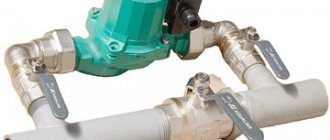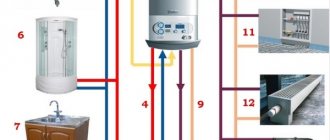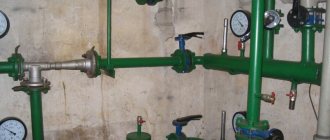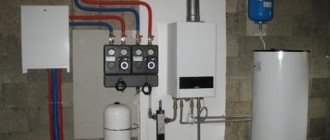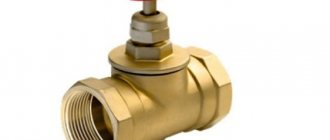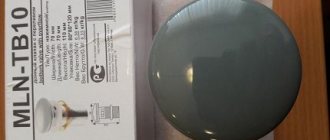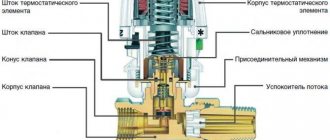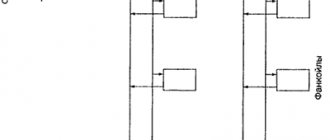Definition
A valve is a type of pipeline drive valve in which the valve body rotates around its own axis, placed perpendicular to the direction of flow. A typical faucet consists of two main elements: a fixed body and a rotating plug.
Ball valve
A valve (shut-off valve) is a type of actuator valve in which the valve body, moving in the direction of flow, sits on a seat. The valve is designed to open, close and regulate the flow of gas or liquid.
Valve
General characteristics of different types of shut-off valves
Shut-off valves are used in the construction of gas and sewer systems. It can be seen on general purpose piping, industrial piping, industrial piping with special operating conditions, sanitary piping and many others. They are designed to block any water or gas flows.
For these purposes, a gate valve, tap, valve, valve, as well as other locking mechanisms are used. Household plumbing cannot do without such mechanisms, but few people understand the difference between a faucet and a valve. Without this, it is simply impossible to connect household appliances, fix a leak, turn off the gas or change the mixer. Plumbing surrounds us all around us, and shut-off valves are an integral part of it.
In fact, it has significant differences, both structural and operational, although any design solution for this type of fittings always works in two positions: closed and open.
But, based on their functional characteristics and scope of application, one or another type of device is selected. To make the right choice, you should know how the principle of their operation may differ, and what function each of them performs.
Return to contents
Comparison
The main difference between a valve and a faucet is that a valve can regulate the pressure of the working flow, but a faucet cannot (besides, adjustment with a faucet is strictly prohibited according to the operating rules). The tap performs only two functions, having only the “open” or “closed” position, and the valve can easily regulate the pressure of the working flow.
It's all about the design differences between the valve and the tap. In valves, the shut-off element sits on a seat, moving in the direction of flow, and in taps it turns around its own axis. In addition, valves are usually ball valves, that is, when the ball is turned, the diameter of the hole changes, and the valves are equipped with a main axle box (by unscrewing or twisting the rod of the main axle box, they raise or lower the valve attached to the rod, thereby opening or closing the hole located in saddle).
Both devices are types of shut-off valves that are installed in pipeline systems to regulate the supply of the working medium. They open and close transported substances, protect equipment from emergency situations. They have some similarities and fundamental structural differences.
Products are mounted by welding, couplings, flanges, threads. In all types of joints, except welded ones, additional gasket materials are used to increase the tightness of the joint.
A valve is a valve whose closing element moves with the help of a threaded pair parallel to the flow, that is, it follows in one direction. It supplies and stops the movement of liquid or gas. Allows you to control the pressure power. This occurs due to a narrowing of the nominal bore diameter.
The devices are either pass-through or corner. The former are characterized by parallel axes of inlet and outlet connecting pipes. The second ones are perpendicular.
The valve is used to open and close the pipe lumen. The shut-off organ, located inside the body, has the shape of a ball, cone or cylinder. Therefore, reinforcement is divided into ball, cone, and cylindrical. Rotating around its axis, the valve moves perpendicular to the transported product, completely blocking the pipeline cross-section. In accordance with the operating rules, it is strictly prohibited to adjust the pressure with the device.
Ball valve diagram
What are the main differences
It is customary to distinguish three types of fittings depending on their purpose:
Some classifications add a safety group.
Considering the main differences between a valve and a ball valve, it is worth noting that in the first mount it is possible to adjust the fluid flow. A ball valve is not capable of performing this task. Based on current regulations, controlling and changing the flow of liquid using a ball valve is strictly prohibited by safety regulations. This is primarily due to the limited functions, since the regulator can only open or close the flow.
With the help of a valve, changes in the operating pressure are allowed due to the water pressure in the pipelines.
This is all due to design differences that determine the functions and use of elements. Considering the main elements of the fixed valve body, the shutter mechanism in it “sits” on the seat. Its movement is carried out in the direction of the flow.
When operating a crane, turns are carried out around its own axis. If additional elements are needed, plumbers use ball elements. When the ball begins to rotate, the diameter in the hole automatically changes.
The valve is equipped with a ground box. When the stems are screwed in/out, the valve moves up and down.
Comparing both designs, several conclusions can be drawn:
- The valve is in the closed and open positions.
- The valve is also capable of regulating the pressure.
- To visually recognize whether it is a valve or a faucet, just pay attention to the handle. The faucet's structure is quite simple, unlike the valve (here it is presented in the form of a lamb).
When considering the main types of shut-off valves, it is recommended to consider another popular element - the valve.
There are several types of cranes, based on the body of rotation:
- Conical. Visually resembles the shape of a truncated cone. The hole can be seen in a rectangular or round shape. Most often used in gas supply. Popular due to its price.
Fig 2. Cone
- Cylindrical. Chief regulator of the heating system. Can perform vertical movement to regulate fluid flow.
Fig 3. Cylindrical
- Ball. No plumber can do without it. The hole is made in a round shape through which the medium passes.
Fig 4. Ball
Types of valves and taps
Such significant design differences between a valve and a ball valve determine the principle of their operation. The first type is applicable not only for opening/closing the flow of substances moving inside the pipe, but also for adjusting it. The second type is used to supply or shut off substrates in a pipeline.
Types of ball valves
The main difference between a valve and a faucet is that the latter are represented by product models capable of not only stopping, but also changing the direction of movement of substances:
- two-way - used to block or open the movement of substances moved to one side of the pipeline;
- three-way L-shaped - characterized by the ability to change the direction of flow of substrates and completely stop their movement in the pipe;
- T-shaped - used to separate the flow, combine or change its direction.
It should be noted that taps are also intended to open or close a flow. If it is necessary to reduce the flow force in a certain section of the pipe, select a device with the appropriate cross-section of the hole in the sphere:
- full bore - the locking mechanism does not affect the substrates flowing through it, which is ensured by matching the diameter inside the hole to the existing pipe;
- standard bore - the lumen of the shut-off ball is 20–30% narrower compared to the cross-section of the connected pipeline;
- partial bore - the narrowing value ensures a reduction in pressure by 30–60% of the original value.
Depending on the material used to make the ball valve, its technical characteristics differ.
- Brass. Applicable only for operation in systems with neutral substances, the temperature of which does not exceed 150°C and the pressure does not exceed 40 bar. The nominal cross-section of the valves ranges from 8 to 100 mm. They are distinguished by their ability to effectively withstand temperature changes and are immune to corrosion.
- Steel. They are susceptible to corrosion and are quickly destroyed when interacting with aggressive compounds, therefore they are mounted on pipes, the main medium being water or other non-aggressive compounds. The maximum flow force that steel taps can withstand reaches 160 bar, and the temperature reaches 200°C. They are distinguished by the production of products in a wide range of nominal sections from 15 to 600 mm.
- Stainless. They are resistant to aggressive substances and lack corrosion damage. Capable of withstanding pressure up to 60 bar, provided that the temperature of the substances in the pipe is not higher than 210°C.
- Cast iron. Shut-off valves used only in hot or cold water supply piping systems.
Why do you need a valve, the main advantages and nuances
A type of fitting where the adjustment part moves in a perpendicular position, moving in the direction of flow. Among representatives of this category, the valve is considered more relevant.
Fig 5. Gate valve
The tool is popular in use:
- Transport activities, where the diameter of products ranges from 15-2000mm;
- In creating water and gas supply;
- In the housing and communal services sector;
- Oil production.
The prevalence of the use of valves is due to the following aspects:
- Easy to operate;
- Small sizes;
- Allows operation in various conditions;
- There is a slight resistance in the hydraulics.
The last aspect is important when constructing highways. Constantly carried out in an environment characterized by high speed.
The mechanism is not without serious nuances. When choosing the necessary tools and materials, experts do not recommend using designs where the spindle is retractable. The shutter stroke is at least one diameter.
It is customary to distinguish two types of valves:
- Full bore.
Fig 6. Full bore
- Narrowed.
Fig 7. Narrowed
The first one is the most common. In it, the full bore diameter is equated to the value of the pipeline on which the tool is installed. To reduce the amount of torque, valves are used to control the control of valves, including reducing the wear rate of other pipeline components.
There are several principles for controlling valves:
- Manually;
- By means of an electric drive system;
- By means of a pneumatic drive system;
- Through a hydraulic drive system.
Considering the comparative characteristics between a tap and a valve, we can conclude that both elements have a number of similar features and differences.
How does a valve differ from a ball valve by type of installation?
Both types of fittings have a threaded and flanged type of connection to the pipeline. However, each has differences in the range of nominal diameters. For a coupling connection it looks like this:
- valves - DN from 15 to 300 mm;
- taps - DN from 8 to 100 mm.
At the same time, ball valves also have other types of installation:
- Wafer - DN from 15 to 200 mm;
- for welding - DN from 10 to 600 mm;
- combined - DN 15 to 200 mm.
What is the difference between a valve and a faucet?
The significant difference between these two types of pipe fittings is that the valve is designed to regulate the flow of a moving substance. The tap is capable of operating only in the “open/closed” mode ; it does not provide intermediate options for the position of the locking body. Using it to regulate movement will lead to rapid wear.
The valve valve has a disc-shaped closing element, like a valve, and is also designed to regulate the flow.
Which is better: ball valve or valve
The choice of a specific type of fittings largely depends on the operating conditions. If at the installation site there is no need to regulate the intensity of movement of the substance inside the pipe, then you should opt for a ball valve. It is characterized by tightness, ease of design and use.
A valve (or valve) is suitable in situations where it is necessary to adjust the force of movement of substances in the pipe. Smooth rotations of the flywheel will allow you to accurately determine the pressure required for a specific period of time.
Which is better: valve or ball valve? There is no specific answer. Each of these types of pipe fittings adequately copes with the assigned tasks.
